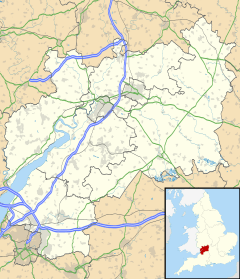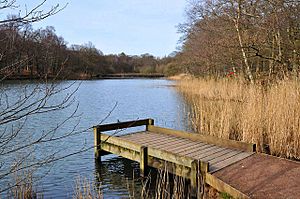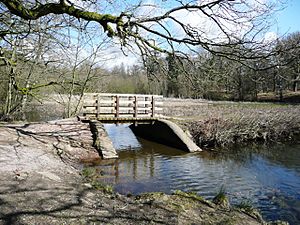Cannop Ponds facts for kids
Cannop Ponds are two large ponds located in the Forest of Dean, Gloucestershire, England. They are just north of a village called Parkend. These ponds and the area around them are very popular with visitors.
Above the top pond, there is a special area of reeds known as 'Cannop Bridge Marsh'. This marsh is a nature reserve. It has been managed by the Gloucestershire Wildlife Trust since 1983. The entire site, including the marsh, ponds, and woods, is known as a Key Wildlife Site.
Contents
Why Were Cannop Ponds Built?
The lower pond was created in 1825. Its purpose was to supply water to a waterwheel. This waterwheel was part of the Parkend Ironworks. However, the water supply was not always steady. So, an upper pond was added in 1829. This helped to provide more water to the ironworks.
What Can You Do at Cannop Ponds?
Cannop Ponds offer many things for visitors to enjoy. There is a large car park for easy access. You can find information boards to learn more about the area. Picnic tables are available for you to have a meal outdoors. There is also a marked walking path to explore.
The ponds are also part of the Forest of Dean Family Cycle Trail. This is a great way to cycle around the area. If you enjoy fishing, the Yorkley Angling Club uses the ponds. Fishing is allowed from May 1st to March 31st each year.
Animals and Birds at the Ponds
Cannop Ponds are a fantastic place to see wildlife. You might spot some beautiful Mandarin ducks. Reed warblers are also common here. A pair of mute swans often build their nest at the ponds. Other birds like moorhens, mallards, and coots live here too.
Exploring Cannop Bridge Marsh
Cannop Bridge Marsh is a special nature reserve. It covers about 9 hectares (about 22 acres). The marsh is surrounded by old industrial sites from the Forest of Dean's coal mining past. The reserve is open to everyone. It is part of the wider Forest Nature Reserve.
The Cannop Brook flows right through the middle of the marsh. It then opens into the northern Cannop pond. On the eastern side, there's an old railway line. This line is now a road used by the Forestry Commission. Old railway sidings at the northern end are now covered with alder and birch trees. A bridge and causeway separate the marsh from the northernmost pond.
Plants and Trees in the Marsh
The marsh is mostly covered with club-rush and bulrush. You can also see great willowherb and common reed. In the drier areas, there are alder and birch trees. The ground under these trees has many grasses and plants like common spotted-orchid. Other interesting plants include marsh pennywort, common valerian, skullcap, and creeping jenny. Wood horsetail grows in damp spots.
Some areas of the marsh are grazed to keep the grass short. Here, you will find sheep's fescue grass.
Birds in the Marsh Woods
The wooded parts of the marsh are home to many small birds. These include nuthatches, chiffchaffs, wood warblers, and treecreepers. You might also see marsh tits, pied flycatchers, common redstarts, and great spotted woodpeckers. Reed buntings also breed here.
Insects and Other Invertebrates
The marsh is a great place for insects. You can find butterflies like the common blue and silver-washed fritillary. There are also different types of dragonflies, such as the large red and blue-tailed damsel-flies. Sadly, the small pearl-bordered fritillary butterfly used to live here but is now gone from the area.
Protecting the Marsh
To keep the marsh healthy and prevent it from drying out, conservationists do special work. They cut back some of the alder trees in the middle of the marsh. They also remove bracken plants. These actions help to protect this important natural area.





